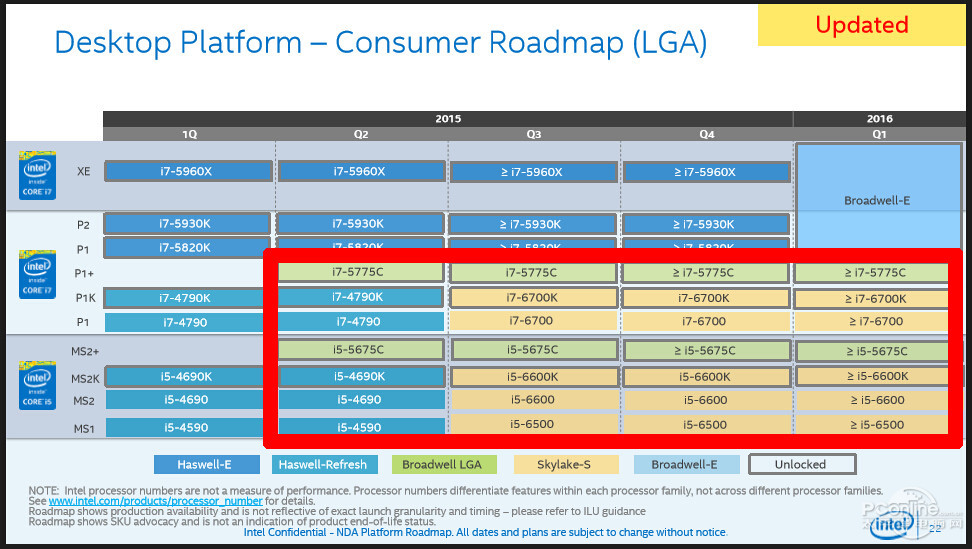A newly published roadmap of Intel Corp. confirms that the company is on track to release its code-named “Broadwell” and “Skylake-S” microprocessors this year as well as “Broadwell-E” chips early in 2016.
PCOnline has published a slide from Intel’s roadmap, which reveals model numbers of Intel’s upcoming central processing units. As expected, Intel is about to introduce “Broadwell Unlocked” processors – the Core i7-5775C (4 cores/8 threads, 3.30GHz/3.80GHz base/turbo frequency, 6MB cache, Iris Pro 6200 graphics core, 65W TDP) and the Core i5-5675C (4 cores/4 threads, 3.10GHz/3.60GHz base/turbo frequency, 4MB cache, Iris Pro 6200 graphics core, 65W TDP). The lineup of “Broadwell” chips in LGA packaging will be limited to only two models.
Sometimes in the third quarter of this year Intel intends to launch its “Skylake-S” microprocessors, including high-end Core i7-6700K (4 cores/8 threads, 4.0GHz/4.20GHz base/turbo frequency, 8MB cache, integrated graphics core, 95W TDP) and Core i5-6600K (4 cores/4 threads, 3.50GHz/3.90GHz base/turbo frequency, 6MB cache, integrated graphics core, 95W TDP) models. The chips will come with unlocked multiplier and will substitute Intel’s current-generation “Devil’s Canyon” products.
In the first quarter of 2016 the world’s largest maker of microprocessors plans to unveil its “Broadwell-E” chips for high-end desktops. The new central processing units will be made using 14nm process technology and are expected to feature up to eight cores along with relatively high clock-rates.
Intel did not comment on the news-story.
Discuss on our Facebook page, HERE.
KitGuru Says: It looks like after rather significant delays, Intel’s 14nm product lineup is about to hit the desktop PC market. Hopefully, Intel will make enough processors and there will be no shortages.
 KitGuru KitGuru.net – Tech News | Hardware News | Hardware Reviews | IOS | Mobile | Gaming | Graphics Cards
KitGuru KitGuru.net – Tech News | Hardware News | Hardware Reviews | IOS | Mobile | Gaming | Graphics Cards




Apparently Skylake will have only 10-15% performance improvement over 4790k so not much in terms of gaming.
what about laptops with non-u broadwell or skylake
anyone know what the IV means next to some of the CPUs in the slide ? at first i was thinking they were bringing in III – V Semiconductor materials
Its ≥ not IV, means greater than or equal to (specified CPU model), so Intel could (or not) release something better/newer, yet unspecified.